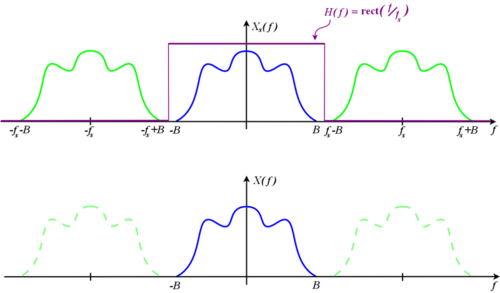HW3_Signal Reconstruction_Interpolation (Band-limited)
After having creating a sampled version of your original function, $ X_{s} $, we need to reconstruct the original function $ x(t) $. To do this, the Whittaker-Shannon interpolation formula is utilized.
The sampling theorem says that given a function that meets two requirements:
- 1) It is band-limited. This means that the Fourier transform of the original signal, also known as the spectrum, is 0 for |f| > B, where B is the bandwidth.
- 2) It is sampled at the Nyquist frequency, $ f_s > 2B $
it can be exactly reconstructed from its samples.
To recover the signal, the sampled function is simply multiplied by a low-pass filter with height equal to the sampling period T, $ {H_r}(f) $, to isolate the original signal.
$ {X_r}(f) = {H_r}(f){X_s}(f) $
Mathematical Process for finding $ {X_r}(f) $:
$ {X_r}(f) = {H_r}(f) \cdot {X_s}(f) $ where $ {H_r}(f) = T {rect}(Tf) $
$ x_r(t) = h_r(t) * x_s(t) = sinc(t/T) * \sum_{n=-\infty}^{\infty} x(nT)\cdot \delta(t - nT) $


